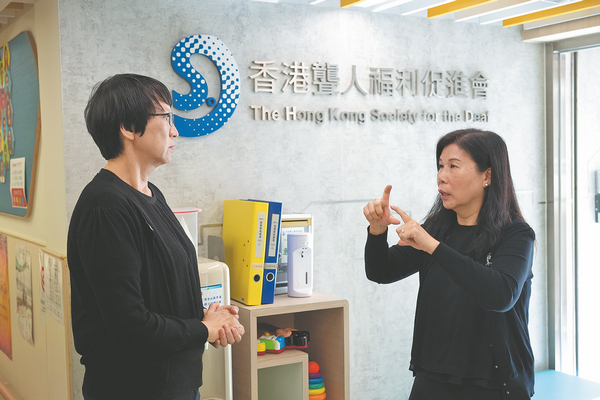

HONG KONG — "Hello! My name is Wanzy. I'm a cat lover," sign language interpreter Wanzy Lo says, placing three fingers horizontally on her face when introducing herself.
This hand gesture represents cat whiskers and the "W" in Wanzy, forming Lo's name in sign language.
Lo, Sign Language Officer of the Hong Kong Society for the Deaf, participated in teaching the public to create their own names in sign language during an activity to promote the communication method late last month.
Sign language interpreters of the Hong Kong Society for the Deaf not only convey word meanings accurately but also capture the essence of the messages to increase "readability".
This April, Lo and one of her colleagues were invited to serve as sign language interpreters at the Hong Kong Film Awards.
This was Lo's first time interpreting sign language for an entertainment-oriented live broadcast program. She strived for excellence despite feeling the pressure.
"Film is an art. When interpreting, it's not just about rigidly conveying information to the audience but also expressing the emotions," Lo says.
When handling singing performances and touching speeches, she would exaggerate her facial expressions to make the deaf audience more engaged.
Nearly 10 years ago, the Hong Kong Special Administrative Region government and the Legislative Council began introducing instant sign language interpretation for important meetings, with the Hong Kong Society for the Deaf playing a pioneering role.
Sign language interpretation is challenging, especially in live programs, which require quick responses and rapid delivery. Interpreters must pay attention to various information in their daily lives.
Lo emphasized that whether translating text or interpreting sign language, one must possess a broader knowledge base to do the job well.
To date, there are nine full-time sign language interpreters in the society and their schedules are always packed.
Demand for sign language interpretation services in Hong Kong is quite high. Between 2023 and 2024, the society provided over 82,000 sign language interpretation services.
According to the "List of Sign Language Interpreters in Hong Kong "set up by local welfare organizations, there are currently more than 50 sign language interpreters in the special administrative region who meet the basic requirements.
Timmy Chan, head of the Sign Language Center of the Hong Kong Society for the Deaf, says that although people with hearing impairments can communicate through writing or mobile phone messaging apps, face-to-face sign language remains the ideal method for them.
"Sign language interpreters are an important bridge between the hearing impaired and the outside world," Chan says, hoping that more people will join the ranks of sign language interpretation so that those with hearing disabilities can benefit.